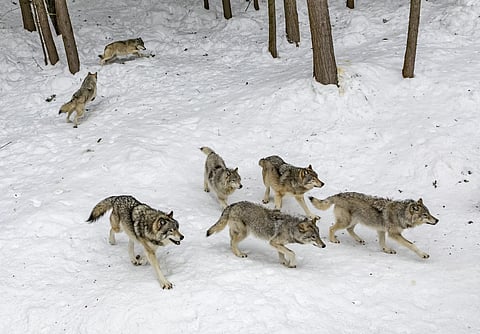

If you ever watch a wolf in the wild, the first thing you notice is its silence. A wolf does not crash through a forest or stomp across snow. It moves like a shadow — alert, careful and aware of every shift in the wind. But one wolf alone is only a small part of a larger story. Hidden somewhere beyond the trees or the hills, others are watching, listening and preparing to act. Wolves are rarely solitary for long because everything about their survival depends on cooperation. To understand why wolves almost never hunt alone, you have to understand the extraordinary way a wolf pack thinks and behaves.
A wolf pack is not just a crowd of wolves travelling in the same direction. It is a family with a structure so well organised that scientists often compare it to a finely tuned team. Each wolf has a place, a role and a purpose. At the centre is an experienced male and female who guide the behaviour of the group. They do not lead through loud commands or displays of dominance every minute of the day. Instead, their leadership is woven into calm decision-making, experience and trust. The younger wolves learn by copying the older ones, watching every movement, every pause and every reaction.
Wolves must hunt in groups because the animals they pursue are almost always larger, stronger or faster than they are. A single wolf cannot bring down a full-grown deer or an elk. Even a skilled hunter would be injured, thrown off balance or simply outrun. But a pack changes the equation completely. What one wolf cannot achieve alone, a coordinated team can complete with precision. It is teamwork born from necessity — the kind that has evolved over thousands of years of survival in harsh landscapes.
Before a hunt begins, wolves use a combination of quiet signals that pass through the pack like ripples. A slight lift of the head, the shift of the ears, a sideways glance — all of these can mean something. Wolves read each other with remarkable accuracy, sensing mood and intention through subtle behaviour. There is rarely chaos or confusion. Even excitement is controlled. The pack remains as silent as possible, because silence is its greatest weapon.
When prey is spotted, the wolves do not charge blindly. They test the herd with quick, strategic movements. They run forward just enough to see which animal stumbles, hesitates or looks weaker than the rest. Wolves know that a hunt is not won through speed alone; it is won by identifying the right target. A herd of deer or elk reacts like a single organism, turning and scattering in patterns that can confuse predators. But wolves understand these patterns. They read the flow of the herd and position themselves accordingly, splitting into small groups that anticipate how the prey will move.
Each member of the pack has a role. Some wolves are excellent at chasing. Others are better at blocking escape routes. Older wolves conserve their energy and focus on guiding the strategy, while younger ones act as runners, driving the prey in the right direction. This division of work is not formally assigned — it develops naturally through instinct, experience and observation. A wolf pup grows up watching the adults and slowly steps into the role that suits its skills best.
During the chase, the pack communicates not through loud barks or howls but through movement. A quick sprint to the left signals a shift in direction. A widening of the circle signals an attempt to corner. A sudden slow-down means the prey is tiring. Wolves are masters of energy management. They run in waves, letting one group push forward and then fall back while another group takes over. This rhythm allows them to chase animals that might otherwise outrun them.
When the chosen prey finally slows or stumbles, the wolves close in. But even then, the hunt is not chaotic. They approach from angles that minimise risk, avoiding kicks, antlers or sudden lunges. Their goal is not aggression but efficiency. A successful hunt feeds every member of the family — pups, elders and adults. Cooperation ensures that everyone survives, and that the pack remains strong enough to hunt again.
This teamwork extends beyond hunting. Wolves care for injured members, share food, protect pups and travel long distances without losing unity. When pups are too young to travel, adults bring food back to the den. When an elder wolf slows down, the pack adjusts its pace. There is a level of empathy and social intelligence within a wolf pack that many animals do not possess. Scientists studying wolves often remark that their behaviour reflects not only instinct but also emotion, learning and memory.
Part of the reason wolves communicate so well is that they rely on many senses at once. Smell, sound, sight and even touch shape their understanding of the moment. A soft whine can express reassurance. A gentle nudge can direct a younger wolf to safety. Even their famous howl serves more than one purpose: it announces territory, reinforces bonds and gathers the pack after it has spread out.
All of this makes the wolf one of nature’s most successful cooperative hunters. Unlike solitary predators that rely only on speed or strength, wolves rely on planning, silent signals and the strength of their relationships. They survive because they understand something essential: a family that works together is stronger than any single individual.